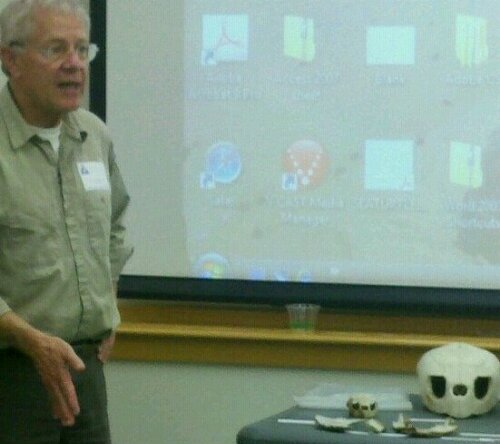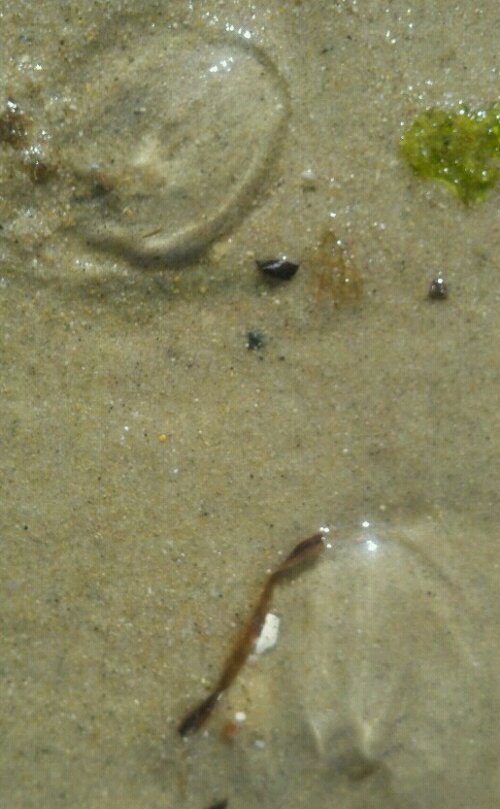
The Stranding Weekend field school has begun this evening at Mass Audubon’s Wellfleet Bay Wildlife Sanctuary.

The Stranding Weekend field school has begun this evening at Mass Audubon’s Wellfleet Bay Wildlife Sanctuary.
Nuisance Green Algae (Bryopsis)
Turtle Journal regularly surveys the dock fouling flora and fauna in Sippican Harbor in search of new species and bio-invaders that may have moved into our local shoreline communities. We were surprised this week to discover a nuisance green algae flourishing along the floating docks at Marion’s Town Landing in Sippican Harbor between Tabor Academy and Burr Brothers marina. This lush green seaweed called Bryopsis comes in two-dimensional Christmas tree shaped (pinnate) fronds. What’s stunningly interesting about this species is that each two-to-six centimeter long “feather” is a singular unicellular organism!
Marion Town Landing in Sippican Harbor
Bryopsis sp. ranges in protected shallow waters from tropical to temperate climes. Frequently considered a nuisance species in the wild, Bryopsis was commonly used in aquariums and has been know to “escape” into the natural habitat and to overwhelm native species. Its unique unicellular organization, combined with an ability for both sexual and asexual propagation, allows for rapid evolution and adaptation. Species can change so rapidly that morphology (shape) alone cannot be used for identification. Scientists opt for DNA analysis to differentiate species.
Â
Bryopsis Proliferates along Sippican Docks
Many times each year, we stretch out on the floating docks along the west shore of Sippican Harbor to sample the fouling communities that have accumulated through the summer months. The extent of vibrant green colors congregating just below the waterline immediately caught our attention. Sue Wieber Nourse, who has been surveying and documenting Marion shoreline specimens for fifteen years, noted she had not seen this species in Sippican Harbor previously. Yet, Bryopsis had proliferated all along the waterline of the town’s floating docks. This nuisance green seaweed thrives in nutrient rich water containing elevated nitrogen levels, as has been reported in Sippican Harbor.
Bryopsis sp.
The specimen above illustrates the size and shape of the pinnate fronds, although the rhizoids of this organism are encased and hidden in a tunicate.  Bryopsis has been described as a beautiful feather-like siphonous green algae. The “stem of the feather” (central axis) is called the thallus with symetrical fronds on either side.Â
Single Cell “Feather” of Bryopsis
From the specimen above, you can see that the fronds are bipinnate. This “feather” represents one of the longer specimens we observed in Sippican Harbor at six to seven centimeters length. A factor that allows for proliferation of Bryopsis in the wild is the ability of this organism to produce a foul tasting and noxious protein that wards off predators. It generally out-competes other algae and seaweed for space, light and nutrients. Bryopsis is related to another nuisance green seaweed called Codium, which is a highly invasive species within the Massachusetts coastal community.
Bryopsis Rhizoids (Holdfast)
Examining Bryopsis from stem to stern, we reach the rhizoids (also know as its “Holdfast”) that anchors the algae to the dock and the fouling community.
Close-Up of Bryopsis
This close-up photograph of Bryopsis, which can be enlarged by clicking, illustrates the unicellular nature of the species and the lack of cell walls within the thallus (body). This unicellular aspect can become a vulnerability when the organism is injured and the cell wall is breached, yet Bryopsis sp. has evolved a way to heal itself when the membrane is punctured. Clotting agents (proteins) are released at the site of injury and within 15 – 20 minutes a healing, gelatinous envelope forms at site of injury.Â
Sippican Dock Fouling Community from October 2008
Taking a look back in time at the same fouling community and the same floating docks from two years ago, we can clearly see that no Bryopsis sp. was observed in our October 2008 survey. The source of this nuisance seaweed in Sippican Harbor can only be surmised. Bryopsis sp. has been known in coastal Massachusetts. Whether Sippican patches developed from an escaped local aquarium or lab, or whether they floated in with the tide is unknown and may never be known. Turtle Journal will, however, continue to sample the Sippican shoreline to determine the extent of its presence in the estuary.

Turtle Journal discovered a ctenophore (comb jelly) bloom in the shallows and covering the low tide sands of Silvershell Beach off Sippican Harbor in Buzzards Bay this morning.
Depredated Surf Clam on Scusset Beach
Gusty winds from an early season nor’easter swooped down on Cape Cod Bay from the North Atlantic today. Turtle Journal patrolled north facing beaches from Scusset in Bourne, on the west side of the canal, to Sandy Neck in Barnstable to see if any critters had been driven ashore and were in need of rescue.Â
Thousands of Surf Clams Litter the Wrack Line
We reached Scusset Beach around two in the afternoon at mid tide rising. As we walked the shore we spotted thousands, probably tens of thousands, of small surf clam shells massed along the leading edge of the incoming surf for about a quarter mile of beach. These small clams ranged in length from approximately 15 mm to 60 mm, with the greatest number of clams about 30 mm long.
Depredated Surf Clams by the Thousands
Closer examination revealed that nearly every clam had been depredated with a neatly drilled hole penetrating to the soft animal inside the shell.Â
Drill Holes Clearly Visible in Depredated Surf Clams
We found no likely suspect predators mixed with the shells during our search of the Scusset shoreline.
Caption
To provide a visceral sense of sizing, we placed a nickel on a pile of the surf clam shells and snapped the picture above.  On leaving the beach, we observed thousands of surf clam shells along the morning’s high tide line, partially covered in wind blown beach sand.
Giant Ocean Sunfish Strands in Wellfleet Harbor
Sadly, there has been a spate of ocean sunfish strandings and deaths in Wellfleet Harbor and elsewhere along Cape Cod Bay within the last week. During this time of year pelagic ocean sunfish enter Cape Cod estuaries, apparently to forage in rich fall tidal waters filled with plankton and ctenophores.  Last week Turtle Journal observed a pair of ocean sunfish foraging in Wellfleet Harbor. See Ocean Sunfish Pair Foraging in Wellfleet Harbor. Wellfleet Harbor and other estuaries of the Outer Cape enjoy healthy flushing by as much as a 15-foot vertical tidal difference between the highest high tide (+13 feet) and the lowest low tide (-2 feet). The flow of that much water through such narrow estuaries and along such extensive tidal flats creates a killing zone where these peculiar animals get trapped in the shallows, strand and die.
Sue Wieber Nourse Examines Young Female Ocean Sunfish
On Saturday a young female ocean sunfish got trapped in Chipman’s Cove in Wellfleet Harbor and stranded. She was likely the smaller of the two ocean sunfish that we saw foraging in the harbor last week. Pam Harding, a fall vacationer in a cottage on exquisite Chipman’s Cove who had been alerting us to large megafauna in the harbor, reported the discovery of this sunfish and another one further along the beach. We reached the fresh carcass early Sunday morning.
Documentation of Young Female Ocean Sunfish
We collected morphometric data on this sunfish as she lay in the salt marsh just below the high water line. She measured only 5 feet 2 inches from tip of snout to the trailing edge of her truncated caudal fin. Her height from the bottom tip of the ventral fin to the top of the dorsal fin was 6 feet 4 inches. The design of ocean sunfish and the way they swim through the water, as you can observe in our YouTube video in last week’s post, poses substantial risk in the inter-tidal shallows that swiftly empty during receding astronomical tides.
“Truncated” Caudal Fin of Ocean Sunfish
The truncated caudal fin, also called a clavus (rudder), coupled with the very large span from ventral fin to dorsal fin, makes the ocean sunfish extremely vulnerable as it swims and forages in these inter-tidal waters.Â
Sunfish Pectoral Fin, Operculum over Gills, and Eye
AÂ tiny pectoral fin lies immediately behind the gills which are covered by an operculum, all behind the eyes and the snout.Â
Ocean Sunfish Mouth and Fused Teeth
The open mouth shows the species’ fused teeth. When we examined her gastro-intestinal track, we found plentiful amounts of digested food. In every regard, she seemed an extremely healthy specimen with no indication of a cause of death other than being trapped in the killing zone.
Young Female Ocean Sunfish Ovary
This ocean sunfish was identified as a young female because of the presence of a small ovary and her overall small size.
Under the Microscope: Female Ocean Sunfish Oocytes
Examination of a slice of her ovary under a microscope showed healthy oocytes, consistent with her overall healthy appearance.
Under the Microscope: Close-Up of Ocean Sunfish Oocytes
Don Lewis Reports Second Stranded Ocean Sunfish
A couple of hundred feet north along the wrack line, we found the second ocean sunfish, which had already suffered significant deterioration and decomposition. This specimen had been dead for some time.
Documentation of Young Male Ocean Sunfish
This small ocean sunfish measured a mere 4 feet 2 inches from snouth to caudal fin, and 5 feet 2 inches from ventral fin to dorsal fin. The eye had already disappeared to predators that had also nibbled along the edges of the carcass.
Exposed Bones of Ocean Sunfish Dorsal Fin
Several measurements, such as the width of the dorsal and ventral fins, had to be approximated because the skin had deteriorated.Â
Young Male Ocean Sunfish Testes
This small animal was identified as a young male by the testes.
Small Ocean Sunfish Sliced by Propeller
On Saturday, Carol “Krill” Carson had responded to a report of an ocean sunfish at Linnell Landing in Brewster. The carcass had come ashore about 2 PM in the afternoon. This specimen was identified as a small male and measured between 4 and 5 feet long. The location of deep prop slices at the top of this ocean sunfish suggests that a boat strike was the cause of death.
Giant Ocean Sunfish Forages in Wellfleet’s Chipman’s Cove
Today, Wednesday the 13th of October, Krill discovered another extremely decomposed male sunfish north of Chipman’s Cove in Wellfleet Harbor across from Shirttail Point. And, finally, around sunset tonight Pam Harding reported that she observed another ocean sunfish foraging in Chipman’s Cove, which she thought had departed the cove as the tide receded. We will all keep a careful watch on the cove in the next few days and weeks as this killing zone continues to claim giant ocean sunfish.